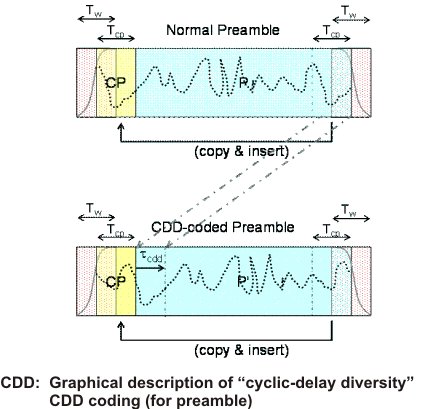Enable Cyclic Delay Diversity (CDD) Measurement (801.16 OFDMA)
Cleared (See OFDMA Standard Presets Table.)
The property applies Cyclic-Delay Diversity measurement analysis. When selected, there is a corresponding CDD metric ( in the Syms/Errs summary table) showing the measured cyclic-delay.
CDD analysis is applied to the measurement analysis.
Using multiple-input channel hardware with CDD analysis
When is disabled (Cleared), both synchronization and analysis of non-MIMO Multiple Input, Multiple Output: A physical layer (PHY) configuration in which both transmitter and receiver use multiple antennas. zones will only use channel 1, or the first input channel, input data. The VSA disregards the user Input channel setting. This implementation adheres to the 802.16e-2005 definition stating that any additional input channels beyond channel 1 (chl 2, chl 3, etc.) does not contain Ant-0 signal information.
When CDD is enabled (Selected), the user specified “Input Channel” is used for synchronization and measurement analysis (including RCE Relative Constellation Error is the RMS level of the Error Vector Magnitude, averaged over all subcarriers and all detected OFDM symbols., CDD, etc., data results). For CDD analysis, the VSA assumes that Ant-0 signals using CDD encoding is transmitted on other non-channel 1 Input channels.
About Cyclic-delay-diversity (CDD)
Cyclic-delay-diversity (CDD) is a diversity scheme used in 802.16e OFDMA telecommunication systems, transforming spatial diversity into frequency diversity avoiding inter symbol interference. CDD is an algorithm basestation (BTS Base Transceiver Station - Although specifications differ for each system, the BTS effects radio communication with mobile stations (MS) via its respective radio access system and transmits/receives signals to/from connected radio network controllers (RNC) located along transmission routes.) manufacturers implement to utilize multiple transmission pathways for non-MIMO zones (and preamble) of Mobile WiMAX signals. Basically, this consists of sending identical data from Ant-1 and Ant-0 (in the 2 antenna case) with Ant-1 delayed cyclically within each OFDM Orthogonal Frequency Division Multiplexing: OFDM employs multiple overlapping radio frequency carriers, each operating at a carefully chosen frequency that is Orthogonal to the others, to produce a transmission scheme that supports higher bit rates due to parallel channel operation. OFDM is an alternative tranmission scheme to DSSS and FHSS. symbol, see the following "CDD coding" graphic.

See Also
